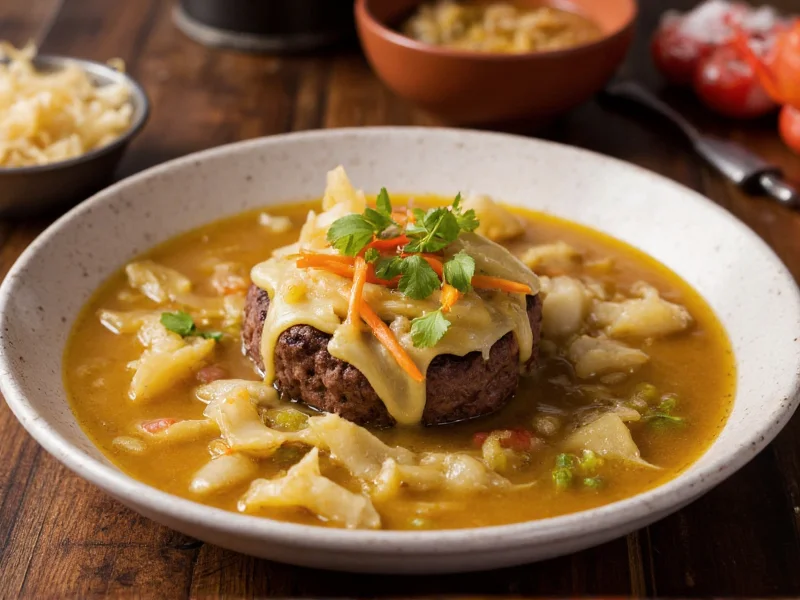Hamburger and cabbage soup represents a practical solution for home cooks seeking nutritious, affordable meals with pantry staples. Originating from Eastern European culinary traditions where resourcefulness was essential, this soup transforms humble ingredients into a deeply flavorful dish. Modern variations maintain the core elements while accommodating dietary preferences through ingredient substitutions.
Essential Ingredients for Authentic Flavor
The magic of this soup lies in its ingredient synergy. You'll need:
| Core Ingredients | Quantity | Preparation Notes |
|---|---|---|
| Ground beef (85% lean) | 1 pound | Brown thoroughly to develop flavor |
| Green cabbage | 1 small head (2 lbs) | Shredded finely for even cooking |
| Crushed tomatoes | 1 (28 oz) can | No salt added preferred |
| Beef broth | 6 cups | Low sodium for better control |
| Yellow onion | 1 medium | Diced small |
| Garlic cloves | 3 | Minced |
Step-by-Step Cooking Method
Follow these professional techniques for optimal results when preparing your hamburger cabbage soup recipe:
- Brown the beef properly: Heat olive oil in a 6-quart pot over medium-high heat. Add ground beef, breaking into small pieces. Cook until deeply browned (not gray) - this Maillard reaction creates complex flavors. Drain excess fat but retain 1 tablespoon for cooking vegetables.
- Sauté aromatics: Add onions and cook until translucent (5 minutes). Stir in garlic and cook 1 minute until fragrant. This builds the flavor foundation for your traditional hamburger cabbage soup.
- Layer flavors: Pour in tomatoes and broth, scraping the browned bits from the pot bottom. These fond particles contain concentrated flavor. Add bay leaf, thyme, salt, and black pepper.
- Add cabbage correctly: Stir in shredded cabbage. Many home cooks make the mistake of adding cabbage too early, causing it to overcook. For ideal texture, add cabbage after liquid ingredients have reached simmer.
- Simmer with precision: Reduce heat to low, cover partially, and simmer 30-40 minutes until cabbage reaches desired tenderness. Stir occasionally to prevent sticking. The cabbage should be tender but still retain some structure.
Proven Techniques for Superior Results
Achieve restaurant-quality hamburger and cabbage soup by implementing these chef-recommended practices:
- Acid balance: Add 1 tablespoon apple cider vinegar during final 10 minutes of cooking. This brightens flavors and enhances the soup's overall complexity without making it taste sour.
- Texture control: For those preferring a thicker soup, remove 1 cup of cooked soup, puree until smooth, then return to pot. This creates body without altering flavor.
- Flavor development: Let soup rest off heat for 15 minutes before serving. This allows flavors to meld and improves overall taste profile significantly.
- Salt timing: Add 75% of salt during cooking, reserving remainder for final adjustment. Cabbage releases water as it cooks, diluting initial seasoning.
Customization Options for Dietary Needs
This adaptable ground beef cabbage soup accommodates various dietary requirements while maintaining authentic flavor:
- Gluten-free version: Naturally gluten-free when using certified GF broth. Check labels on all packaged ingredients.
- Lower-carb adaptation: Reduce tomato quantity by 50% and increase broth proportionally. Add 1 cup chopped zucchini during final 15 minutes.
- Vegetarian alternative: Substitute ground beef with 2 cups cooked lentils and 1 cup chopped mushrooms. Use vegetable broth and add 1 tablespoon soy sauce for umami.
- Spicy variation: Include 1 diced jalapeño with onions and 1/2 teaspoon red pepper flakes during sautéing for a flavorful kick to your hamburger cabbage soup.
Serving and Storage Recommendations
Maximize enjoyment of your homemade hamburger and cabbage soup with these professional tips:
- Serving temperature: Serve at 165°F (74°C) for optimal flavor release. Cooler temperatures mute complex flavors.
- Garnish wisely: Add fresh dill or parsley just before serving. A small dollop of sour cream provides creamy contrast to the tangy cabbage.
- Storage method: Cool completely before transferring to airtight containers. Properly stored, this soup maintains quality for 4 days in the refrigerator.
- Freezing technique: Freeze in portion-sized containers for up to 3 months. Thaw overnight in refrigerator before reheating gently to preserve cabbage texture.
- Reheating protocol: Warm over medium-low heat, stirring occasionally. Avoid boiling which can make cabbage mushy in your ground beef cabbage soup.
Nutritional Benefits of This Comfort Food
Contrary to perceptions of being merely comfort food, a standard serving (1.5 cups) of hamburger and cabbage soup provides:
- Approximately 290 calories with balanced macronutrients
- 22g protein supporting muscle maintenance
- 7g dietary fiber from cabbage promoting digestive health
- Significant vitamin C, K, and B6 from fresh cabbage
- Iron and zinc from quality ground beef
The dish exemplifies how traditional recipes can deliver both comfort and nutrition when prepared with attention to ingredient quality and cooking technique. This makes it an excellent choice for those seeking satisfying yet health-conscious meal options.











 浙公网安备
33010002000092号
浙公网安备
33010002000092号 浙B2-20120091-4
浙B2-20120091-4